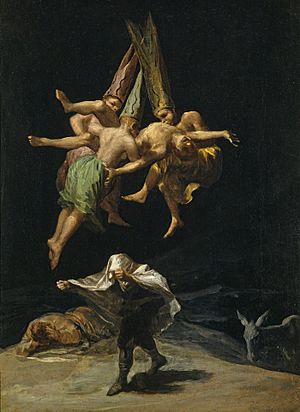Witches' Flight facts for kids
Quick facts for kids Witches' Flight |
|
|---|---|
| Spanish: Vuelo de Brujas | |
 |
|
| Artist | Francisco Goya |
| Year | 1797-8 |
| Medium | Oil on canvas |
| Dimensions | 43.5 cm × 30.5 cm (17⅛ in × 12 in) |
| Location | Museo del Prado, Madrid |
Witches' Flight (which in Spanish is Vuelo de Brujas) is a famous painting by the Spanish artist Francisco Goya. He finished this oil painting on canvas in 1798. It was one of six paintings about witchcraft that were bought by the Duke and Duchess of Osuna in 1798. Many people think it is the most striking and powerful of Goya's paintings about witches.
The painting was sold to the Duke and Duchess of Osuna on June 27, 1798. They wanted it to decorate their country house, called La Alameda, near Madrid. Over the years, the painting changed owners a few times. It was sold in 1896 and again in 1985. Finally, the Prado Museum bought it in 1999. You can see it there today.
What's Happening in the Painting?
This painting shows three figures floating in the air. They are dressed in strange, pointed hats called corozas. These hats look like flames pointing upwards. The figures are flying over two people on the ground.
The two people below are dressed like peasants. They seem very scared by what they see. One person has fallen to the ground and is covering their ears. The other person is trying to hide under a blanket. They are also making a special hand gesture, called the fig gesture, to try and keep bad luck away.
On the right side of the painting, there is a donkey. The donkey looks like it doesn't even notice what is happening above it. It seems completely unaware of the strange scene.
What Does the Painting Mean?
Many art experts believe that Witches' Flight is Goya's way of criticizing old beliefs and a lack of knowledge. He especially focused on how these ideas affected religion.
The pointed hats worn by the flying figures are very important. These coroza hats were worn by people who were punished by the Spanish Inquisition. The Inquisition was a powerful religious court in Spain. The upward flames on the hats showed that these people were seen as unrepentant heretics. This meant they were believed to have gone against religious teachings and would face severe punishment.
However, the hats also look a bit like the tall hats worn by bishops in the church. This suggests that Goya might have been saying that the actions of the religious courts were just as superstitious and ritualistic as the witchcraft they were fighting against.
The people on the ground can be seen in different ways. Maybe they are shocked but feel helpless to do anything. Or perhaps they choose to ignore what is happening and don't want to get involved.
The donkey in the painting is also a symbol. In art, a donkey often represents a lack of understanding or knowledge. So, the donkey not noticing the witches could mean that some people are simply unaware or choose to remain ignorant.
See also
 In Spanish: Vuelo de brujas para niños
In Spanish: Vuelo de brujas para niños
- List of works by Francisco Goya

